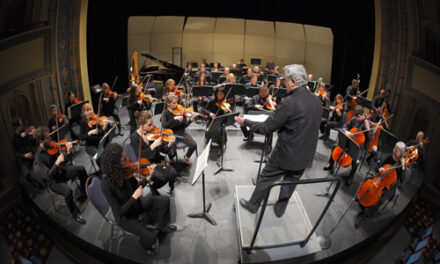The Monday night Faculty Chamber Music Series concerts of the Eastern Music Festival take place in the warm acoustical Recital Hall at the University of North Carolina Greensboro School of Music, Theatre, and Dance. Use of folk elements linked the two strongly contrasted works by Antonin Dvořák (1841-1904) and Anton Arensky (1861-1906).
Dvořák may have been inspired to compose his Serenade in D minor for Wind Instruments, Cello, and Double Bass, Op.44 after hearing a performance of one of Mozart’s serenades for those instruments. Eighteenth century serenades often had a number of movements and served as background music for aristocratic parties. Dvořák’s Op. 44 is in four movements and is an example of the composer’s growing use of folk music. Like its 18th century models, a march opens the first Moderato movement and returns to close the Allegro molto finale. The second movement is dominated by the rhythm of a “sousedska,” a minuet-like Czech dance performed by elderly couples while a quicker central portion has a livelier rhythm similar to a “furiant” dance. The deeply engaging third movement, Andante con moto, opens with an extended singing cantilena interrupted by a vehement episode before the return of the reverie. Rousing folk-like rhythms dominate the finale before the reprise of the march.
Dvořák composed Op. 44 for pairs of oboes, clarinets, bassoons, and three French horns to which he added cello and double bass to enhance the bass line. According to Wikipedia, an optional part for contrabassoon was also available but was not used by this performance. The musicians were oboists Katherine Young Steele and Karen Birch Blundell while the scheduled clarinetists were Shannon Scott and Anthony Taylor. However, a hand injury kept Scott from performing so Taylor took her place while student clarinet concerto winner, Alec Manasse,* took Taylor’s place. Bassoonists George Sakakeeny and Karla Ekholm were joined by Kevin Reid, Jacob Medlin,** and Andrew McAfee on horns. Cellist Amy Frost Baumgarten was joined by double bassist Leonid Finkelshteyn.
Dvořák’s Serenade bubbles over with high spirits and lively and richly varied rhythms which were brought out by the EMF ensemble. Frequent exchanges in turn between the first oboe and clarinet led off to a sequence of their themes by the others in turn. The color of the various pairings was a constant delight. A choice moment came near the end of the third movement with the exchange between Steele and Taylor underpinned by a bass line of three horns. Each player in the ensemble made the most of the composer’s many opportunities to shine or blend.
Arensky’s music reflects two opposing schools of nineteenth century music. At the Saint Petersburg Conservatory he was taught by Nicholai Rimsky-Korsakov (1844-1908), one of the “Mighty Five” who strongly advocated for a national music based on native folk melodies and rhythms. After graduation, Arensky became a professor at the rival Moscow Conservatory where Tchaikovsky modeled more on the Western styles of Mozart and the Italian opera composers.
Arensky’s most often performed music is his Piano Trio No. 1 in D minor, Op.32 that is in four movements. It is imaginatively scored for all three instruments, abounds in winning melodies, and fully exploits their color and range. The EMF stellar performance was given by faculty pianist, the internationally renowned Awadagin Pratt, equally distinguished guest violinist Anne Akiko Meyers, and cellist Julian Schwarz who ought to become as well-known based on his performance of the Elgar cello concerto earlier in the week.
Meyers spun the first theme above murmuring piano triplets to be followed by a song-like second theme from Schwarz’s remarkably rich-toned cello. The third theme followed at a faster tempo. The violin theme dominated the development section before all three came back before a hushed ending. The Scherzo juxtaposed Pratt’s florid, virtuosic keyboard against brief, spare string parts. One of the delights of this live performance was the sight of the unusual bowings, especially by Meyers to exploit the higher positions of the violin. The third movement, Elegia: Adagio, pays homage to the Russian cellist Karl Davidoff. Both strings are muted giving a haunting, veiled quality. Schwarz’ playing of the extended opening melody was achingly beautiful. All three players brought out the intense drama of the Allegro non troppo of the finale with its exploitation of themes from the Elegia and the first movement. Enthusiastic music lovers gave the three multiple recalls.
*EMF clarinet student Alec Manasse is the son of the distinguished clarinetist Jon Manasse who has been heard in both the Triad and Triangle areas frequently. Cellist Julian Schwarz was once an EMF student and concerto winner and is the son of EMF Music Director Gerard Schwarz.
**Jacob Medlin replaced Joy Branagan this evening. Edited 7/29/15.











